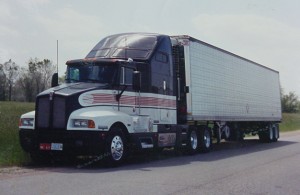Park Service releases EIS Scoping Report
April 29th, 2010
Imagine 190 foot transmission towers through the Delaware Water Gap, between Pennsylvania and New Jersey.
That’s what’s proposed by PSE&G for its Susquehanna-Roseland transmission line. This quad/tri bundled 500kV line is HUGE, ugly beyond belief, and it’s just so big that I can hardly comprehend, there’s nothing that large that I’ve found. Others like it are being cancelled by PJM due to lack of demand, and this one should be too…
From the Pocono Record:
Anyway, the National Park Service is doing an Environmental Impact Statement, and leading up to that is “scoping,” which, as Grant Stevenson noted yesterday at the Task Force meeting, is THE most misunderstood term. I agree. It just zooms over people’s heads, and comments end up being of the “I hate this project because___” and nothing that relates to what the scope of the environmental review should be. Utter waste of time, and something to be mindful of with the CapX 2020 transmission scoping meetings coming up.
SCOPE: Range, area of coverage, breadth
So “scoping” in this sense is the range, area of coverage, and breadth of environmental review.
We had comments on the scope a few months ago, and there were something like 6,500 comments. Yes, that’s right, SIX THOUSAND FIVE HUNDRED! At the meetings I went to, it was standing room only and the comments were notably on point, they were profound examples of those rare uplifting meetings. Facilitation of the meetings was so good it felt like they really were interested in what we had to say. It was all taken down by a court reporter. THAT level of attention and appreciation is SO rare… and dig this … afterwards I RECEIVED A THANK YOU NOTE FOR PARTICIPATING. That is a first, I’ve never gotten a thank you note from an agency for showing up and speaking out. I’m thinking of framing it (after sending it to MN’s Dept. of Commerce).
NATIONAL PARK SERVICE – SUSQUEHANNA-ROSELAND 500kV TRANSMISSION LINE PAGE
Here’s their report:
The next step?
We’ll keep you posted.
It’s the end of an era…
April 25th, 2010
That’s my “Kelly Truck” on a Sunday night after a wash, and some dilled potatoes for me, at the Magic Wand in Vegas.
I’ve just cleaned out the closet under the stairs and put my truck stuff up on freecycle… sniff… sob… it’s the end of an era, but it’s time to admit that I’m probably not going back to driving a truck. I still go nuts every Friday at sunset, and it’s hard to drive with ameteurs. My life in two places and work all over the country sort of satisfies that road jones but… but… trucking? It’s done…
ZU ENDE!!! FINE!!!
Terrorist activity and electric infrastructure?
April 24th, 2010
Xcel Energy”s Hiawatha Transmission Project is sticking in my craw again. I’m having one of those “Xcel is evil” kind of days. Xcel is hiding reliability information under a claim of “Security.” How absurd can they get? Don’t they get that if I was going to blow up substations, a) I don’t need their stupid info to do it, and b) I would have done it a long time ago? Earth to Mars, that’s not my M.O. But noooooooooo…
I’ve been looking at Xcel’s SAIDI, SAIFI and CAIDI distribution reliability reports, one of the things I’m happiest about in the 2001 legislative session. Minn. Stat. 216B.029. Why? Because Xcel’s Scott Zima testified at the public hearing for the Hiawatha Transmission Line Project that the claimed “reliability” problems did not show up in their SAIDI, SAIFI and CAIDI reports. WAS ANYONE LISTENING?
What is SAIDI, SAIFI and CAIDI? They’re distribution reliability indices. Here are definitions stolen from Rochester Public Utilities 2009 Electric System Engineering & Operations Report:
- SYSTEM AVERAGE INTERRUPTION DURATION INDEX – SAIDI
SAIDI is defined as the average duration of interruptions for customers served during a specified time period. Although similar to CAIDI, the average number of customers served is used instead of number of customers affected.
The unit of SAIDI is minutes. A common usage of SAIDI is: “If all the customers on the distribution system were without power the same amount of time, they would have been out for _________ minutes”.
- SYSTEM AVERAGE INTERRUPTION FREQUENCY INDEX – SAIFI
SAIFI described the average number of times that a customer’s power is interrupted during a specified time period. “SAIFI-short” is calculated using the number of customers affected by momentary interruptions (such as brief breaker or recloser operations). “SAIFI-long” is calculated using the number of customers affected by sustained interruptions.
The units for SAIFI are “interruptions per customer”. A common usage of SAIFI is: “On the average, customers on the distribution system experienced _______ interruptions”.
- CUSTOMER AVERAGE INTERRUPTION DURATION INDEX – CAIDI
CAIDI is the weighted average length of an interruption for customers affected during a specified time period.
The unit of CAIDI is minutes. A common usage of CAIDI is: “The average customer that experiences an outage on the distribution system is out for ___________ minutes.”
Here’s some background info about SAIDI, SAIFI and CAIDI reports from Edison Institute:
Here’s the Minnesota rule about reporting SAIDI, SAIFI and CAIDI:
7826.0500 RELIABILITY REPORTING REQUIREMENTS.
Xcel has to file these reports annually. And since Xcel’s Mr. Zima’s testimony that the reliability problems they claim as the basis for need for the Hiawatha Project are NOT reflected in the SAIDI, SAIFI and CAIDI reports (WAS ANYONE LISTENING?), I spent some time looking at the annual reports filed this year:
Xcel’s Initial Filing – Docket 10-310
Xcel’s Initial Filing – Docket 10-310 – Attachment D – Part 1
Xcel’s Initial Filing – Docket 10-310 – Attachment D – Part 2
And there’s another older docket where similar information was recently filed:
Xcel’s Annual Filing – 02-2034 – Part 1
To search these dockets,go to www.puc.state.mn.us and click on “Search eDockets” and then plug in the docket numbers.
And here’s an example of what’s wrong with this picture – look at the crudely whited-out Feeder Line column:
Who cares? Well, I do… why? Because when they say that the distribution system is such a problem that they need a big honkin’ shiny new transmission line, and then one of their engineers testifies that this distribution “reliability problem” they’re whining about and inflicting an oversized transmission “solution” on a community about ISN’T showing up in the SAIDI, SAIFI and CAIDI distribution reliability reports, that’s a problem. IS ANYONE TRACKING THIS? It’s not rocket science, it’s basic vetting of their claims!
Looking at their letter in the filing in Docket 02-2034, there’s this amazing statement:
Security Data
The raw reliability data provided with this filing includes “security data” as
defined by Minn. Stat. § 13.37, subd. 1(a). Xcel Energy believes that some of the
raw data on the disks and/or that has been eFiled could be manipulated to reveal
the location and size of certain facilities that have been summarized in the
Monthly Report. The public disclosure or use of this information creates an
unacceptable risk that those who want to disrupt the electrical grid for political
or other reasons may learn which facilities to target to create the greatest
disruption. For this reason, pursuant to Minn. Stat. § 13.37, subd. 2, we have
excised this data from the public version of our filing.p. 5, Xcel’s Annual Filing – 02-2034 – Part I (emphasis added).
Excuuuuuse me?
The public disclosure or use of this information creates an unacceptable risk that those who want to disrupt the electrical grid for political or other reasons may learn which facilities to target to create the greatest disruption.
What a load o’ crap. It is so illogical — those they’re having problems with aren’t necessarily, and probably just AREN’T, the ones to target to create the greatest disruption!
So I calls up Xcel, I do… and leave a message with Bria Shea because Jody Londo who signed the cover letter with the “Security” note was not in, explaining what info in what dockets I’m looking for and that I’m wanting to sign a confidentiality agreement to get it.
But noooooooooooo, guess again. I get a call back from someone in “Legal” (I didn’t know they had an Illegal department) and here they are making a bogus argument about PUBLIC disclosure, and I’m asking for disclosure with a confidentiality agreement. She wants to know if I’m a party, which I’m not, there are no parties in these dockets. And even if a party, even with a confidentiality agreement, no, because it’s a SECURITY issue. Oh, yeah… right… I’m a terrorist, wanting their “feeder line” information to take out electricity to some select target… Guess she’s been talking to Mike Krikava, thinking only a terrorist would want to enter a 2005-MAPP map into a transmission proceeding. That’s as wacky as a judge thinking it’s appropriate to do a transmission proceeding without a map entered in as evidence!
So now I get to “evaluate my options.” It’s possible to do some triangulation with the reports and with the Attachments to Xcel’s Hiawatha Project Application, but… sigh… we all know what their concern is — that someone might read it and make some sense of it, and understand what it means.
BPU issues Susquehanna-Roseland Order
April 21st, 2010
It’s out, hot off the press:
I feel a Motion for Reconsideration coming on…
Injured, but not dead!
April 21st, 2010
I’ve had a few inquiries as to whether I was dead! So FYI — no, sorry Xcel, I’m not, but when my Kady-doggy went after Lake, the big happy yellow lab down the block, no way could/would I let go and she took me with her, I took a dive, and without my generous padding, I’d be flat on my back in Ortho with a tib-fib fx and external fixator… OH MY DOG!!!! I hit right below my knee and thought I’d broken it, that little 1″ spot bruised instantly and darkly, but it wasn’t broken. Then overnight my leg from the knee down swelled up so bad I could barely get pants on, and my ankle all around turned the most vivid purple, and over the next two days, it slowly creeped upward to my knee. Felt like it was going to burst! The part I landed on remained just a small spot of purple and everything else was a psychedelic collage. Shoes? Forget it! Walk? Hobble at best… Finally, after ice packs, TEDs, and 6 days later, I can say with confidence, YUP! I am going to live.
So back to work!






